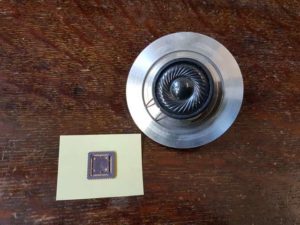- in Gear by Bobby Owsinski
Will We Be Using Graphene Speakers Soon?
 Let’s face it, loudspeaker transducer technology hasn’t had a real breakthrough in over a hundred years. Every improvement (and there have been many) has been an evolution and not a revolution. That could change soon thanks to some groundbreaking research from the University of Exeter that uses graphene as a transducer.
Let’s face it, loudspeaker transducer technology hasn’t had a real breakthrough in over a hundred years. Every improvement (and there have been many) has been an evolution and not a revolution. That could change soon thanks to some groundbreaking research from the University of Exeter that uses graphene as a transducer.
“What’s so groundbreaking about that?” you might say. Isn’t that just a loudspeaker with a membrane made out of atom-thin carbon? The big deal about this is that the researchers have found a way to make graphene into what essentially amounts to a speaker, equalizer and amplifier on a chip the size of a thumbnail. There are no moving parts involved!
A layer of the atomically thin material graphene is rapidly heated and cooled by an alternating electric current, and transfer of this thermal variation to the air causes it to expand and contract, thereby generating sound waves. With graphene being almost completely transparent, that would mean that the speaker/EQ/amp combination could be built into walls, glass, furniture, or your computer monitor.
According to Dr David Horsell, a Senior Lecturer in the Quantum Systems and Nanomaterials Group at Exeter and lead author of the paper, “Thermoacoustics (conversion of heat into sound) has been overlooked because it is regarded as such an inefficient process that it has no practical applications. We looked instead at the way the sound is actually produced and found that by controlling the electrical current through the graphene we could not only produce sound but could change its volume and specify how each frequency component is amplified. Such amplification and control opens up a range of real-world applications we had not envisaged.”
The researchers aren’t looking at the audio business as the recipient of the technology though. What the team has in mind is more along the range of ultrasound imaging, for use in hospitals and other medical facilities in the future.
Dr Horsell added: “The frequency mixing is key to new applications. The sound generating mechanism allows us to take two or more different sound sources and multiply them together. This leads to the efficient generation of ultrasound (and infrasound). However, the most exciting thing is that is does this trick of multiplication in a remarkably simple and controllable way. This could have a real impact in the telecommunications industry, which needs to combine signals this way but currently uses rather complex and, therefore, costly methods to do so.”
That said, I have no doubt that the audio scientists in our industry will get hard to work to turn the technology into something that we’ll see in our studios soon. Graphene speakers anyone?

